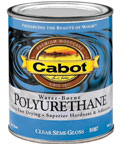Water Based Floor Finish
When you’re finishing your own wood floors, you’ve got a few options as to floor finish types–but one tends to stand out: the water based floor finish.
After all, finishing wood floors is a messy, smelly process that often forces homeowners out of their houses for days at a time…so why make things harder by using icky, hard-to-use oil-based or Swedish finishes?
Water based…sounds simple and pure, huh?
As with anything good, there is a downside. But let’s look at both sides and let you decide.

Water Based Finishes – Good
- Easy clean-up due to the water base. Cleans with water.
- Low smell.
- Simple application with a lambswool pad and stick–a tool that’s easy to obtain and cheap from most home improvement stores.
- A watery consistency–it glides on, rather than thickly gooping on like an oil finish or shellac.
- Penetrates into the wood well, due to its water base and thin consistency.
- And the best…water-based floor finishes are really quite idiot-proof. It’s easy to take a half-assed approach and still end up with a great looking floor.
Water-based floor finishes are fairly “half-assed-proof.” Even if you screw it up, it’s hard to screw it up.
Water Based Finishes – Bad
I hate using the word “bad,” so can we say “not so good”? With water based floor finishes there is nothing truly horrific. More than anything, these finishes lack the “oomph” factor that some of the other finishes have.
- So watery that you can hardly believe it’s doing anything for your floor. Consequently, you tend to over-apply it.
- Its milky white color is hard to discern on the floor. You don’t quite know where you’ve applied it, so again, you tend to over-apply it.
- As with any type of thin or water-based finish, it raises the grain of the wood.
- If you’re looking for a real dramatic color change (without using stains), you won’t get it with the water based finish. Light tone only here.
- Less protection than with poly-based finishes, due to fewer solids (and more water!) in the mix.